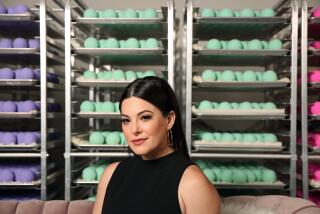DOW CORNING’S BANKRUPTCY FILING : Twice Distressed : O.C. Activist to Keep Fighting Despite Latest Blow
- Share via
LAGUNA HILLS — Marie Walsh was awakened at 5 Monday morning with the news that Dow Corning had filed for bankruptcy protection.
The call came from a distressed woman in New York, one of thousands in a network that Walsh helped create through her pioneering efforts to hold the giant plastics company responsible for defects in silicone breast implants--defects like the one that she says caused her implants to rupture more than a decade ago.
Walsh, a mother of eight who has been struggling with sickness since 1981, was glad that Dow Corning had fallen to its knees. But the 47-year-old Laguna Hills woman said she feared the bankruptcy filing was nothing but a way to skirt responsibility and compensation to victims.
“It reeks, it smells so bad. The women are being victimized again,” she said in an afternoon interview, her voice weary from a morning visit to the doctor.
Dow Corning officials said Monday that they had little choice but to file for bankruptcy protection, because of the unexpectedly large number of women who decided not to be part of the global settlement and have instead sued the company in courthouses across the country.
Walsh, who filed a suit against Dow Corning in 1991, finally had a trial set for Aug. 2. But the Chapter 11 bankruptcy filing has thrown her lawsuit into limbo, along with thousands of other court actions nationwide.
“We’re just going to have to wait and see what happens,” said Ramon Rossi Lopez, Walsh’s attorney. Lopez’s firm in Newport Beach represents about 500 women who have had breast implants, including one whose trial was scheduled to start Monday. “I was working all weekend getting the case ready,” Lopez said.
“I wasn’t surprised [by the bankruptcy filing],” he added, “but I didn’t think it was going to be Monday.”
Walsh wasn’t surprised either; she had heard rumors for the past three weeks that Dow Corning was contemplating such action. But with the court filing, Walsh reflected on her long crusade, saying it was time to renew her battle.
“It just means we have to buckle our belt and get ready for a big fight,” Walsh said, standing in her kitchen on thongs instead of shoes because she says ailments from the breast implant pain her from toe to scalp. “If it takes a march in Washington, or if we have to picket in front of Dow Corning, whatever we have to do, I’ll be there.”
*
Walsh has been waging her David vs. Goliath fight for five years, having become perhaps the leading spokeswoman for recipients of breast implants. From the dining room of her home, she founded the Breast Implant Information Foundation, which provides information and encouragement to implant recipients.
Over the years, she has testified at Food and Drug Administration hearings; pictures of her scarred chest have appeared on national television.
“At one time, I think when [the news show] ’48 Hours’ was at my house, we were getting 100 calls an hour,” Walsh wrote in her latest newsletter. And she has flown around the world in her mission, despite constant pain that requires 20 pills a day at a cost of $700 a month.
Walsh’s odyssey began in 1968, five years after silicone gel implants were first used. Then 20 years old, Walsh paid a Santa Ana plastic surgeon $1,200 to correct her left breast, which she said had never developed. But in 1981, her first symptoms emerged: muscle aches, night sweats, hair loss.
Then one morning in February, 1984, she awoke in a blood-drenched nightgown, her implant having ruptured overnight. Since then she says she has had a litany of afflictions, including rheumatoid arthritis, scleroderma--an abnormal hardening of body tissues--and chronic lymph, kidney and liver problems. Walsh said she and her doctor believe that the silicone gel from implants migrated through her body and wreaked havoc in her immune system.
Since 1990, Walsh, a former stockbroker, has been on disability, receiving about $600 a month in Social Security disability payments. She has carried on her crusade through private donations and help from her husband, Jim Walsh, who operates a sports development business from their four-bedroom home.
He said he has told her to stop the battle more than once, adding that he even threatened to leave her. “Thank God she didn’t listen to me,” he said Monday. “She knew this was bigger than our marriage.”
*
Marsha Chambers, a 46-year-old Rancho Santa Margarita woman, said she has been sick from silicone gel implants since 1986. She worked alongside Marie Walsh in the early 1990s but had to quit three years ago when she got too sick.
In an interview Monday, Chambers said she was disheartened by Dow Corning’s bankruptcy filing. “I don’t think it’s fair,” she said. “I don’t care if I get millions of dollars; I just need something to survive on.”
Chambers said one of her implants was found to have been used and contaminated, but its manufacturer is no longer in business. So like thousands of others, Chambers had no one to sue and was thus added to a large pool awaiting a global settlement.
Chambers says she is supporting her 17-year-old son on an $800 disability check every month, though rent on her one-bedroom apartment alone costs $675 monthly. Chambers said her husband left, she lost her car and she cannot work because she ails from arthritis, lung and breast diseases and other illnesses.
Chambers said Walsh’s perseverance has been courageous. “She has been sick longer than me,” Chambers said. “But she’s sacrificed her own health to help others.”
* MAIN STORY, A1
* CASE STUDY
Lessons from Manville’s asbestos-related filing. D17
(BEGIN TEXT OF INFOBOX / INFOGRAPHIC)
The Dow Corning Saga
Once the nation’s biggest supplier of silicone gel breast implants, Dow Corning Corp., a 50-50 joint venture of Dow Chemical Co. and Corning Inc., sought bankruptcy protection Monday, blaming a crush of implant litigation. Some facts and figures about the implant products and a history of the suit:
Implants * More than 2 million women worldwide have breast implants. So far, more than 410,000 have registered as claimants under a settlement proposed by implant makers. * Claimants complain of headaches, joint pain and chronic fatigue. They say silicone implants cause connective-tissue diseases such as scleroderma, lupus and rheumatoid arthritis. * According to the National Institutes of Health--which has invested more than $500,000 in researching a possible link between silicone implants and illness--no definitive evidence has been found linking silicone to various autoimmune diseases. * In March, Structured Biological International Inc. won approval for the first blood test to detect an immune response resulting from exposure to silicone. * Bills pending in the House and Senate would limit the liability of suppliers of biological materials, including silicone. These companies would also be affected by tort reform legislation pending in Congress. * More than 150,000 breast augmentations--averaging $2,400 a procedure--are performed annually. About 80% of the procedures are cosmetic; the remainder are breast reconstruction following cancer surgery.
Chronology * Dec. 3, 1993: U.S. District Judge Sam Pointer dismisses Dow Chemical and Corning as defendants in thousands of lawsuits involving health problems blamed on silicone implants. * March 23, 1994: Dow Corning agrees to pay $2 billion of $4.23-billion settlement of thousands of breast implant claims after nearly two years of negotiations. * Sept. 1, 1994: Judge approves settlement. * Sept. 15, 1994: New Zealand women begin appeal of settlement, blocking initial payment of $900 million. * Jan. 20, 1995: Dow Corning and Bristol-Myers Squibb Co. set aside additional millions of dollars for settlement because of unexpectedly large number of women registering. * April 25: Dow Chemical is reinstated as defendant in implant cases nationwide. * May 3: Women’s lawyers and implant makers begin new negotiations after court analysis shows more money will be needed to make first wave of settlement payments. * May 4: Dow Corning says it is actively considering retreat into Bankruptcy Court. * May 15: Dow Corning files for Chapter 11 bankruptcy protection.
Sources: Associated Press, Biomedical Market Newsletter, Times reports. Researched by JENNIFER OLDHAM / Los Angeles Times
More to Read
Sign up for Essential California
The most important California stories and recommendations in your inbox every morning.
You may occasionally receive promotional content from the Los Angeles Times.











